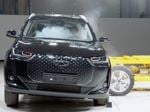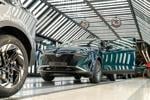The UK has some of the most efficient assembly plants in Europe, so why are carmakers still considering opportunities abroad, asks Julian Rendell.
BRITAIN'S CAR FACTORIES are heading for a 30-year high in new car output, but this welcome news is being overshadowed by tough times for the vital parts supply industry.
Output from the 16 major car plants in Britain is tipped to hit 1.9m units by 2005, according to industry observers, equalling the heady days of 1972 when BMC dominated the UK sales charts.
But today's high value of Sterling and uncertainty over the Euro is increasingly forcing manufacture of components, the bedrock of any nation's car industry, abroad.
In fact, the problems facing the component industry are causing such concern that last week the SMMT issued an unprecedented warning: “We want a decision from the government on the Euro as to whether we will be in or out. Uncertainty is the problem. And for the component industry the problem is horrendous.”
The UK's supplier base is being eroded at a frightening pace. Three of the biggest inward investment projects of the last few years — the new Mini, new Range Rover and Nissan Micra replacement — illustrate the problem.
The rule of thumb for 'local content', the proportion of parts supplied from the same country as the assembly plant, used to be around 70 per cent. But the high value of Sterling is forcing companies to outsource much bigger proportions of their bought-in components from the EU or eastern Europe.
As a result, just 30 per cent of the new Micra is sourced from Britain and 40 per cent of the new Mini and Range Rover. “We call it the 'hollowing out' of the supply chain,” says SMMT spokesman Al Clarke, “and it ends up with cars as just a shell of appearance. What seems British-built is just an assembly of parts from outside the country.” It also has implications for dealer parts departments, repairers and bodyshops, which are faced with delays on orders because the parts have to be sourced from abroad.
One of the most successful factories in Britain – Peugeot's Ryton plant in Coventry – has been prospering with its 'foreign parts' strategy. A huge success story in terms of unit output, Ryton will pump out 230,000 206 models this year on four shifts. Just five years ago, it survived on just 73,000 cars.
But the factory is essentially a 'screwdriver' plant, assembling cars from major components like body panels and engines supplied from the continent. It's a stark contrast to integrated plants like Nissan's Sunderland factory or Honda's Swindon plant.
The Nissan plant has its own body-panel press shop, engine foundry and axle sub-assembly lines, while Honda also presses its own panels and assembles engines in Britain. In fact, since 1984 Nissan has sunk £2bn into Sunderland and Honda £1.15bn into Swindon since 1992.
But the question mark over the Euro made the £235m sunk into the Micra replacement one of the toughest wrangles ever in the history of British automotive investment. A similar battle is brewing over the Almera replacement — due on sale around 2005 — and once again Nissan boss Ghosn has made no promises in advance.
An equally high-profile battle is already panning out over the future of Ryton, the latest twist being a delay to the decision on a new £100m paintshop, which was expected at the end of 2002 in anticipation of a new 206 model around 2006.
The solvent-based paintshop is now said to be capable of passing new environmental laws due in January 2006, so PSA Peugeot-Citroen boss Jean-Martin Folz has temporarily parked the decision.
But a number of recent strikes over pay by dissatisfied employees at the plant has not encouraged him to make a quick final decision – privately Folz is said to be fuming over the developments, which have cost Peugeot millions of pounds in lost production.
In the meantime, Peugeot is upping its charm offensive with the Government by appointing Tod Evans as a lobbyist in new offices in London, effective in April.
Despite such agonising twists and turns, the car industry in Britain is still considered world-class, helped by high productivity and low overall labour costs.
Nissan can still boast its plant as the most productive plant in Europe, with 95 cars per employee per year, ahead of Ford and Toyota with 87 each. Professor Kumar Bhattacharyya, of Warwick University, estimates UK labour rates at around half those of the European competition. “Ryton's big problem is nothing to do with the Euro, it's the French unions asking why PSA isn't investing in France,” says the plain-speaking academic.
Despite question marks over the health of the local supplier base and some future investments, the SMMT remains optimistic for the future of car assembly in Britain. “The industry has been going through tough times for the past 18 months, but UK manufacturing has increased output and is well placed to take advantage of any upswing,” says its chief economist Paul Everitt.
Like most observers, Everitt reckons that total UK car output is heading for 1.9m units in 2005, on the back of a wave of investment in new models.
After the dark days of 2000 and 2001, when production dipped to 1.64m and 1.49m respectively on the back of Ford and Vauxhall's axeing of Dagenham and Luton, that's a welcome development.
But as the SMMT points out, it is matched by a structural change in the car-making landscape, with pricier luxury brands, led by the Ford-owned Premier Automotive Group (Jaguar, Land Rover and Aston Martin), VW-owned Bentley and BMW-owned Rolls-Royce and premium-priced Mini, cranking up production at the expense of volume brands.
By the end of 2005, Jaguar and Land Rover are expected to be pushing out around 380,000 units combined. Today, they're managing around 300,000, but they both have important additional models coming.
At September's Frankfurt show, Jaguar is expected to reveal much-needed diesel versions of the X- and S-type and its first-ever estate, on the X-type platform.
For the former Ford plant at Halewood, the new X-type models can't come a moment too soon. Production was stopped for three weeks in February to soak up unsold stock. And last year Halewood employed just 68 per cent of a possible 107,000 units per year. Eighty per cent is the industry target.
Despite reporting a shocking £320m loss last year, Jaguar still pledges to keep its three plants open. “We're not talking plant closures,” says a spokesman.
Land Rover is also clawing back sales, predicting around 175,000 this year, to equal 2000's record. And looking to the future, Land Rover is also investing in an additional model, the BMW X5-chasing 'Range Sport', its fifth model scheduled to be built in volumes of around 40,000 a year by early 2005, boosting output of UK plc.
Both Land Rover and Jaguar rely on exports — between 70 and 80 per cent of output goes abroad. Jaguar is particularly reliant on the US market, which takes 50 per cent of sales, Land Rover less so with 25 per cent going Stateside.
The BMW Mini is also a huge success story. When BMW Oxford was making the Rover 75 (now in production at Longbridge), capacity was set at 100,000. With sales of the Mini Diesel, due for launch this summer, and the Mini Cabriolet, for launch in spring 2004, that could rise to close to 200,000.
So car-making in Britain looks well-placed for the near future, with 15 plants pumping out record numbers of cars, two-thirds of which go to export. But that's not to say more carmakers won't follow the example of Ford and Vauxhall, particularly if the Government continues to pontificate over joining the Euro.
Question marks also arise over the longer term – maybe in 10 years' time. If the supplier base continues to erode, parts will come increasingly from all over Europe. The badge may say British and the cars may be assembled in Britain, but will they really count as British cars? Only time will tell.












Login to comment
Comments
No comments have been made yet.